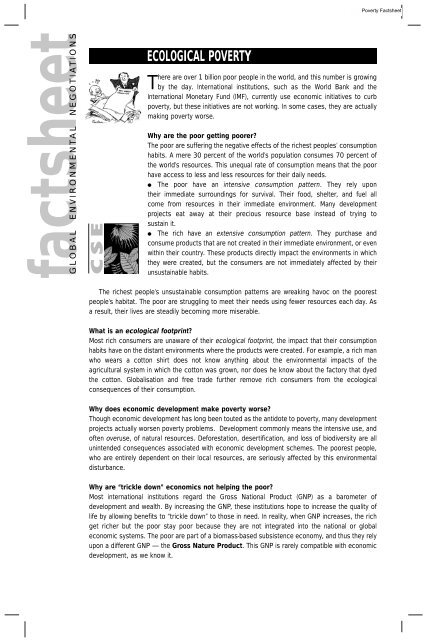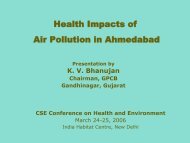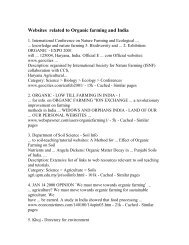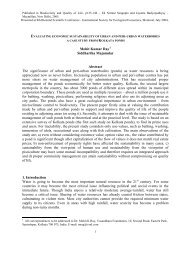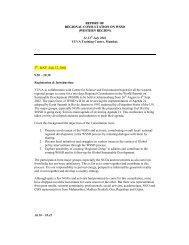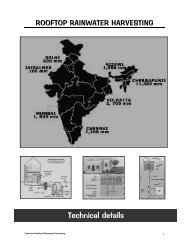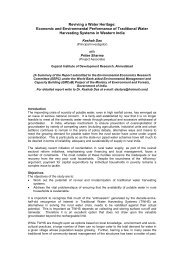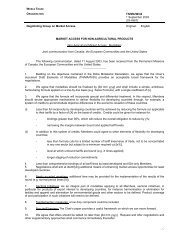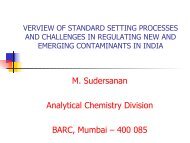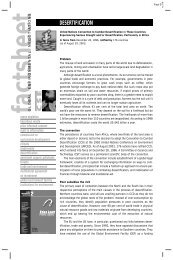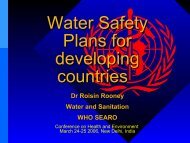ECOLOGICAL POVERTY - Rainwater Harvesting
ECOLOGICAL POVERTY - Rainwater Harvesting
ECOLOGICAL POVERTY - Rainwater Harvesting
Create successful ePaper yourself
Turn your PDF publications into a flip-book with our unique Google optimized e-Paper software.
Poverty FactsheetfactsheetGLOBAL ENVIRONMENTAL NEGOTIATIONS<strong>ECOLOGICAL</strong> <strong>POVERTY</strong>There are over 1 billion poor people in the world, and this number is growingby the day. International institutions, such as the World Bank and theInternational Monetary Fund (IMF), currently use economic initiatives to curbpoverty, but these initiatives are not working. In some cases, they are actuallymaking poverty worse.Why are the poor getting poorer?The poor are suffering the negative effects of the richest peoples’ consumptionhabits. A mere 30 percent of the world’s population consumes 70 percent ofthe world’s resources. This unequal rate of consumption means that the poorhave access to less and less resources for their daily needs.● The poor have an intensive consumption pattern. They rely upontheir immediate surroundings for survival. Their food, shelter, and fuel allcome from resources in their immediate environment. Many developmentprojects eat away at their precious resource base instead of trying tosustain it.● The rich have an extensive consumption pattern. They purchase andconsume products that are not created in their immediate environment, or evenwithin their country. These products directly impact the environments in whichthey were created, but the consumers are not immediately affected by theirunsustainable habits.The richest people’s unsustainable consumption patterns are wreaking havoc on the poorestpeople’s habitat. The poor are struggling to meet their needs using fewer resources each day. Asa result, their lives are steadily becoming more miserable.What is an ecological footprint?Most rich consumers are unaware of their ecological footprint, the impact that their consumptionhabits have on the distant environments where the products were created. For example, a rich manwho wears a cotton shirt does not know anything about the environmental impacts of theagricultural system in which the cotton was grown, nor does he know about the factory that dyedthe cotton. Globalisation and free trade further remove rich consumers from the ecologicalconsequences of their consumption.Why does economic development make poverty worse?Though economic development has long been touted as the antidote to poverty, many developmentprojects actually worsen poverty problems. Development commonly means the intensive use, andoften overuse, of natural resources. Deforestation, desertification, and loss of biodiversity are allunintended consequences associated with economic development schemes. The poorest people,who are entirely dependent on their local resources, are seriously affected by this environmentaldisturbance.Why are “trickle down” economics not helping the poor?Most international institutions regard the Gross National Product (GNP) as a barometer ofdevelopment and wealth. By increasing the GNP, these institutions hope to increase the quality oflife by allowing benefits to “trickle down” to those in need. In reality, when GNP increases, the richget richer but the poor stay poor because they are not integrated into the national or globaleconomic systems. The poor are part of a biomass-based subsistence economy, and thus they relyupon a different GNP — the Gross Nature Product. This GNP is rarely compatible with economicdevelopment, as we know it.
Poverty FactsheetShining exampleIn 1975, the village of RaleganSiddhi in western India was strickenby chronic poverty. Located within adrought-prone area of Maharashtra,the village could produce merely 30per cent of the food it required.Many fields were not irrigated, andthose that were had low crop yields.Most Ralegan men were forced tomigrate out of the village each yearto search for work.A retired driver from the IndianArmy, Krishna Bhaurao Hazare,helped to raise Ralegan’s groundwatertable by constructing storageponds and reservoirs. At the sametime 300,000–400,000 trees wereplanted around the village. The newwater supply increased the farmingarea by 50 per cent. Villagers dugcommunity wells, and used the waterto cultivate more crops each year.They began to export the excessfruit and vegetables to destinationsas distant as Dubai. Soon the villagers’savings reached an incredibleRupees 3 crore (US $0.7 million).To ensure that the new watersupply was distributed equitably,Ralegan developed a Gram Sabha,or village assembly. Thisparticipatory democratic institutionfollowed Gandhian ruraldevelopment philosophy by involvingall villagers in the planning process.The village also incorporatedindividual participation throughShramdan — a voluntary labourprogram. Shramdan provided awork force for developmentprojects, while forging a sense ofunity among the villagers.Ralegan’s remarkable transformationwas made possible by theinhabitants’ commitment to equitablelocal development. The villagersreceived no special treatmentfrom the government; they simplyworked effectively with the officials.The villagers used the Gram Sabha— the village assembly — toarticulate their needs, and thenimplemented projects with thoseneeds in mind.Why should poverty alleviation initiatives be refocused?● Any developmental process that destroys the environment will inevitablylead to more poverty. Economic development needs to be tied toenvironmental conservation. This is especially true in developing countries,where governments yearning for investors may choose money over nature.Economic development easily becomes an exercise in environmental injustice,perpetrated by the rich against the poor:● In highly populated countries like India, where people are using everypossible ecological niche, any environmental degradation will lead to increasedimpoverishment.● Poor people depend more on their immediate environment than theydepend on the national economy. They are unlikely to benefit from thedevelopment projects that degrade their surroundings.● Pollution impacts the poor more than the rich. The rich can protectthemselves from pollution by using their money to avoid unhealthy things: theycan buy bottled water, move to cleaner neighbourhoods, and seek medicaltreatment if necessary. The poor have no option but to use polluted waterways,eat unsafe food, and live with contaminated soil.Why are women more affected by poverty?Household responsibilities: Women are responsible for gathering householdresources such as water, food, fuel, and fodder. Environmental disturbance andextreme conditions make these resources scarce, forcing women to walkfarther and farther every day to find them.Women’s health: Women often take food only after the rest of their familyhas been fed; if there is not enough to eat, they suffer the most. Pregnant andlactating women need more calories, but they often cannot get them. Womenare often malnourished, making them more susceptible to illness.Access to family resources and representation: Women are not usually givencontrol over their family’s money or land. This lack of access to resourcesmakes it difficult for them to better their lives. They are under-represented ondecision-making boards and their perspectives are often ignored.Challenges aheadEmpower the poor: The poor are potentially the best stewards of theirenvironment. Because they are dependent on their surroundings, they have avested interested in ensuring the long-term ecological health of their habitat.With education and funding, they can become ardent supporters of responsibleenvironmental conservation.Rethink development initiatives: The current poverty alleviation initiativesmostly focus on unsustainable economic development. International institutionsshould couple development with environmental protection to ensure that thepoor are not forced to compete with industrial uses of local resources.Focus on community-based projects: The “trickle down” approach to developmentis not working. Resources should be directed to local communities to ensurethat they reach the populations for which they are intended. Suitable projects canhelp the poor gradually integrate themselves into money-based economies.Give women a voice: Poor women are tired, overworked, andundernourished. They often lack the economic and political power to changetheir situation. Development initiatives must propose projects that incorporatewomen into the decision making process, and which focus specifically onwomen. Educating women should be a top priority.


